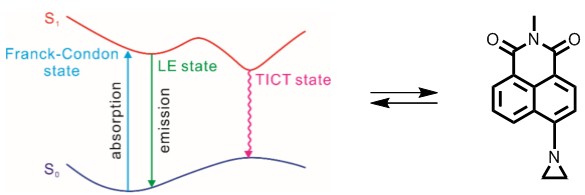One of the fundamental goals in biology is to understand the complex spatio–temporal interplay of biomolecules from the cellular to the integrative level. To study these interactions, researchers use fluorescent labelling and sensing for both in-vivo cellular imaging and in-vitro assay detection. Benified from the small size, low toxicity, covalent linkages with biomolecules and fluorescence from a broad range of wavelengths, organic fluorophores are widedly used in bio-imaging and most promising to reduce the imaging resolution to several nanometer in super-resolution imaging. However, some intrinsic photophysical properties of organic fluorophores, such as low brightness and photostability, environment sensitivity and low specificity, have limited their use in long-term imaging and affect the detection limit and the dynamic range of the method. Cooperation with theoretical chemists, we make a deep understanding of fluorophore working mechanism and then design novel fluorophores with superior optical properties, such as brightness and photostability, environment–insensitivity and large stokes shifts.



